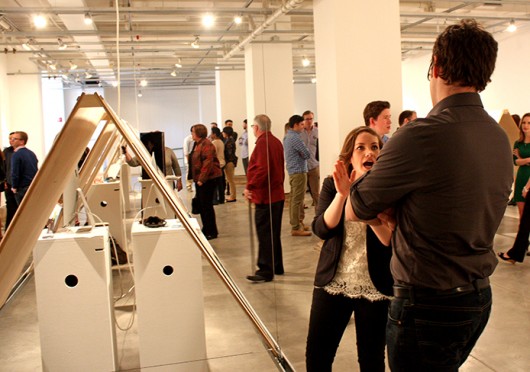
Jennifer Wheat, a fourth-year in interior design, talks about her senior thesis at the OSU design department’s 2014 spring exhibition, which is set to have a public reception April 2 at the Urban Arts Space.
Credit: Sam Harrington / Lantern photographer
For some, the senior thesis has a drab stigma — tedious, visually uninteresting and impractical — but that is not the case for seniors in Ohio State’s Department of Design.
A refrigerator redesign, an online network for upcycling and a better children’s healthcare facility are just some of the senior theses on display in the Department of Design’s 2014 spring exhibition.
The annual nine-day exhibition opened March 26 and showcases the senior thesis projects of undergraduates in industrial, interior and visual communication design, as well as select work from MFA design students, Mary Beecher, Department of Design chairwoman, said Monday in an email.
Students began researching their projects during Fall Semester, and after months of study, interviews, thought and planning, they began designing a prototype of their thesis in Spring Semester. The exhibition functions as a course, thus failing to produce a project means retaking the course — a full year setback.
“If we don’t have something to present in the show, we essentially get set back a year, it’s a failing grade for that class, we have to retake it,” said Adam Scott, a fourth-year in industrial design.
The “pressure to perform” was anxiety-inducing, however Scott said it was worth the stress.
What makes the project worthwhile is “being able to show off my skills and to be proud of what I’m presenting and to show the culmination of four years of learning,” Scott said.
Scott is one of about 50 undergraduate students participating in the exhibition. For his thesis, he chose to design a refrigerator with high content visibility.
“I never know what’s in my refrigerator, there’s a back corner and there’s drawers, I don’t know what’s in there,” he said. Scott’s refrigerator helps to alleviate those problems.
Scott is not alone in designing something that could solve a problem. Jennifer Wheat, a fourth-year in interior design, chose to redesign a children’s healthcare facility so it incorporates speech and occupational therapy.
Some medical facilities are constructed more like office buildings, as opposed to having open spaces that could be more approachable by children, Wheat said.
“If a child needs speech therapy, they are often going to need occupational therapy as well, so it makes the most sense economically and for the child’s health to do both in the same building,” she said, adding that she tried to make an open space where a child could feel stimulated.
In the exhibition, there are two formal events for students to present their work — one for professionals and alumni and one for friends and family. While having your work viewed by those in the professional world is enticing, being able to share your work with those that matter is sometimes more rewarding, Beecher said.
“Perhaps the most fun is the family night … because design careers are not always clearly understood by the general public, this is sometimes a great chance for parents, siblings and friends, etc. to get a clearer picture of just what their loved one has been doing for the past four years,” Beecher said. “It is a wonderful opportunity for the faculty to meet the students’ families and friends and to celebrate the culmination of each student’s time as a design student in our department.”
Besides a way to showcase an individual’s work, the exhibition is also a chance to impress potential employers.
But even with the possibility of a job offer, the exhibition “is more about the project and less about your future job,” said Molly Dennig, a fourth-year in visual communication design.
Dennig’s thesis is an online network for upcycling — artistically reusing old things.
She built a website prototype that would allow people who want to be creative in their recycling, but don’t know what to do, to list and claim items.
“It’s sort of this never-ending cycle of people getting materials, making cool stuff with them and then selling them back,” she said. “I’m really happy with it, I wish it was real.”
Dennig said she is proud of her and her colleagues’ work. The past month was high-stress, but the time and energy spent was well worth the effort.
“I think everyone really likes their project, that’s the good part,” she said. “We’re all just really excited. Excited to be done, but excited that it’s a complete project, something that we’ve done.”
There is set to be a public reception 6-8 p.m. Wednesday at the Urban Arts Space at 50 W. Town St. The exhibition runs through Thursday.


